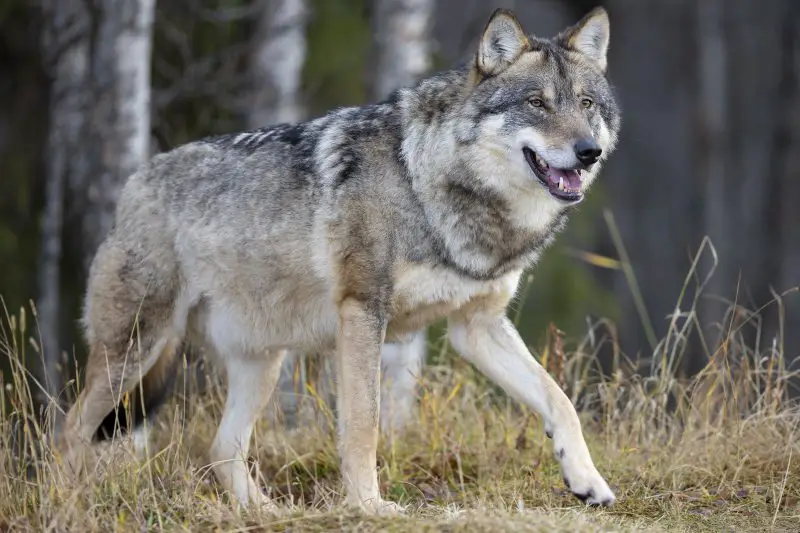California is often associated with golden coastlines, towering redwoods, and sprawling urban areas. But beyond the cities and beaches, wild places still thrive—and among the most intriguing of these wild inhabitants is the gray wolf. Once eliminated from the state, gray wolves have slowly begun to return, sparking curiosity, wonder, and even concern. Understanding this elusive predator—especially its size, coat variations, and key identifiers—can help Californians coexist more peacefully with one of North America’s most iconic carnivores.
This article dives deep into the characteristics of the gray wolf in California, offering insight into their physical traits, how they can be recognized in the wild, and what their presence means for the state’s ecosystems.
The Return of the Gray Wolf to California

The gray wolf once roamed much of California’s wilderness before being extirpated in the 1920s. Following a reintroduction program in the northern Rocky Mountains in the 1990s, wolves began to slowly expand their range. By 2011, a lone wolf known as OR-7 made headlines when he wandered into northern California from Oregon, becoming the first confirmed wild wolf in the state in nearly a century.
Since then, several wolf packs have established territories in California, primarily in remote regions of Siskiyou, Lassen, and Plumas counties. The return of the gray wolf is viewed by many conservationists as a symbol of ecological restoration, though it also brings new management challenges, especially in ranching communities.
General Physical Description of the Gray Wolf
Gray wolves are often mistaken for large coyotes or wolf-dog hybrids, but they possess distinct physical features that set them apart. A fully grown gray wolf stands tall with a commanding presence, reflecting its role as a top predator. Their appearance combines power and agility, enabling them to travel long distances and hunt large prey.
These wolves have long legs, large feet, and a bushy tail that often hangs straight down. Their ears are moderately rounded, and their muzzles are broad compared to those of coyotes. The eyes of a gray wolf are typically golden or amber, giving them an intense, intelligent expression that’s hard to forget once encountered.
In California, wolves generally exhibit the same core features seen in other western populations, though certain environmental factors may influence coat appearance or size variation slightly. Wolves in colder regions might develop denser fur compared to those living in slightly milder Californian conditions.
Average Size of a California Gray Wolf
The size of a gray wolf can be impressive, especially to those unfamiliar with wild canines. Males tend to be larger than females, often weighing between 85 to 110 pounds, though some individuals may exceed this range depending on genetics and food availability. Females typically weigh slightly less, averaging around 70 to 90 pounds.
From nose to tail, a gray wolf may measure 4.5 to 6.5 feet in length. Their shoulder height often ranges from 26 to 32 inches, making them significantly taller and more robust than coyotes or domestic dogs. Despite their size, wolves are agile creatures, capable of running at speeds up to 35 miles per hour for short distances when hunting or evading threats.
In the context of California, wolves are comparable in size to their northern counterparts. The packs monitored by the California Department of Fish and Wildlife have shown healthy weight and size metrics, indicating that California’s wilderness can support viable wolf populations.
Coat Color Variations and Seasonal Changes
One of the most intriguing aspects of the gray wolf is its variable coat color. While the name “gray wolf” implies a uniform gray tone, the reality is far more complex. Coat color in wolves ranges widely, from near-black to creamy white, with many individuals displaying a mix of grays, browns, blacks, and even reddish hues.
In California, the most commonly observed coat colors include grizzled gray with black guard hairs, dark brown, or even black. Some wolves may have light-colored underbellies and facial markings, creating a striking contrast that enhances their wild appearance. These natural camouflage patterns help wolves blend into forested environments, grasslands, and snowy landscapes, depending on the season.
Seasonal molting also plays a significant role in a wolf’s appearance. During the spring, wolves shed their heavy winter coats in favor of a lighter summer coat, which is shorter and less dense. This seasonal change may temporarily alter their coloration and make identification more difficult at certain times of year. By late fall, wolves begin growing in their thicker winter fur, which appears fuller and more uniform.
Distinguishing Wolves from Coyotes and Dogs
It can be surprisingly difficult for untrained observers to distinguish a gray wolf from a large dog or a coyote, especially at a distance. However, several key traits can help identify a true wolf in the wild. Size is the first indicator; wolves are significantly larger than coyotes and most domestic dog breeds. Their legs are longer in proportion to their body, and they carry themselves with a confident, fluid stride.
Wolves also have broader heads with shorter, wider muzzles. Their tails are straight and bushy, typically carried down when walking, whereas coyotes often carry their tails low and tucked. In contrast, domestic dogs vary widely in tail carriage and body proportions depending on breed.
Another critical clue lies in their behavior. Wolves are more cautious and elusive around humans than coyotes or dogs. They move with purpose and often travel in a single-file line when in groups. Coyotes may exhibit more erratic or bold behaviors near urban areas, while wolves remain deeply rooted in wild habitats.
When it comes to vocalizations, wolves produce long, resonant howls that can be heard for miles. These howls are deeper and more prolonged than the higher-pitched yipping of coyotes. While many believe wolves howl at the moon, howling actually serves as a tool for communication, coordination during hunts, and territorial defense.
Wolf Tracks and Signs in the Wild
For outdoor enthusiasts or biologists, identifying wolf presence often involves recognizing indirect signs such as tracks, scat, or kill sites. Wolf tracks are generally larger than those of coyotes or dogs, measuring around 4 to 5 inches long. The tracks are symmetrical with four toes and a distinctive heel pad, and often appear in linear patterns due to the wolf’s efficient gait.
Scat left by wolves tends to be large and tubular, often containing fur, bones, and plant material. When examining potential signs of wolves, location context is critical. Tracks found in remote forested areas of northern California, far from human activity, are more likely to belong to wolves than domestic dogs.
Another common indicator is prey remains. Wolves are capable of taking down deer and elk, and their kill sites often exhibit signs of coordinated hunting—multiple entry points, strategic biting locations, and evidence of group feeding. These sites differ from the messier scenes left by solitary scavengers like bears or mountain lions.
Behavior and Social Structure
Gray wolves live in family-based packs, usually consisting of a breeding pair (often referred to as the alpha male and female) and their offspring from one or more years. Pack size can vary depending on territory, food supply, and survival rates. In California, known packs typically consist of four to eight individuals, though this number fluctuates annually.
Social bonds in wolf packs are strong. Each member has a role, whether it’s scouting, hunting, or caring for pups. Cooperation during hunts is a hallmark of wolf intelligence, allowing them to tackle large prey that would be impossible for a single predator. Communication within the pack involves vocalizations, body language, scent marking, and facial expressions.
The dominance hierarchy ensures coordination without constant fighting. Contrary to older myths, dominance is not always asserted through aggression. More often, it is maintained through subtle behavioral cues and mutual understanding among pack members.
Legal Protection and Conservation Status in California
The gray wolf is listed as an endangered species under the California Endangered Species Act, and federal protections also apply in many circumstances. This means it is illegal to harm, harass, or kill a gray wolf in the state, with exceptions only granted in rare and tightly regulated situations.
The California Department of Fish and Wildlife monitors known wolf packs using GPS collars, remote cameras, and field observations. These efforts aim to track population growth, dispersal patterns, and interactions with livestock and other wildlife. Conservation strategies emphasize public education, conflict mitigation with ranchers, and habitat preservation.
Despite the protections, wolf recovery remains a sensitive topic. Some ranchers worry about livestock predation, though the actual number of confirmed wolf-related losses is low compared to other causes such as disease, weather, or mountain lions. Compensation programs and non-lethal deterrents have been introduced to help reduce these tensions.
Cultural Significance and Public Perception
Throughout history, the gray wolf has occupied a powerful place in human imagination. In Indigenous Californian cultures, wolves are often revered as symbols of strength, loyalty, and intelligence. Traditional stories frequently portray them as wise guides or protectors of natural balance.
In modern times, public perception of wolves is mixed. While many celebrate their return as a conservation success, others fear them due to deeply rooted myths or economic concerns. Movies, books, and folklore have often painted wolves as villains, reinforcing fear and misunderstanding. Education plays a crucial role in reshaping these views and promoting coexistence.
Citizen interest in wolves continues to grow, particularly among wildlife watchers and photographers. Responsible wildlife viewing, supported by distance respect and habitat preservation, ensures that future generations can experience the awe of encountering a gray wolf in the wild.
How to Respond to a Wolf Encounter
While sightings remain rare, the chance of encountering a gray wolf in parts of northern California is no longer impossible. In the event of a sighting, it’s important to stay calm, observe from a distance, and avoid any attempt to approach or feed the animal. Wolves are naturally wary of humans and will typically avoid confrontation if left undisturbed.
If you’re in an area with known wolf activity, keep dogs leashed and livestock secure, particularly during the early morning or late evening hours when wolves are most active. Reporting sightings to wildlife authorities helps support ongoing conservation and research efforts.
Educational signage in parks and forests, as well as outreach programs in rural communities, continue to improve understanding of how to safely share space with this recovering species.
FAQs About Gray Wolves in California
What is the typical size of a gray wolf in California?
Gray wolves in California usually weigh between 70 and 110 pounds, with males being larger than females. Their length from nose to tail ranges from 4.5 to 6.5 feet, and they stand about 26 to 32 inches tall at the shoulder.
How can I distinguish a gray wolf from a coyote or a domestic dog?
Gray wolves are generally larger, with longer legs and broader heads compared to coyotes and most dogs. Wolves have bushy tails carried low, rounded ears, and a purposeful gait. Their howls are deeper and longer than the high-pitched yips of coyotes.
What coat colors do gray wolves in California have?
Their coat colors vary widely, ranging from grizzled gray with black guard hairs to dark brown or even black. Some wolves have lighter underbellies and facial markings. Seasonal changes cause their fur to be denser and thicker in winter and shorter in summer.
Are gray wolves protected in California?
Yes, gray wolves are protected under the California Endangered Species Act, making it illegal to harm or harass them. The California Department of Fish and Wildlife actively monitors and manages wolf populations.
Where in California are gray wolves mostly found?
Most gray wolves in California inhabit remote northern regions, such as Siskiyou, Lassen, and Plumas counties. These areas provide the wilderness and prey base needed to support wolf packs.
What should I do if I see a gray wolf in the wild?
If you encounter a gray wolf, stay calm, keep your distance, and do not approach or feed the animal. Report sightings to local wildlife authorities to help support monitoring efforts.
Do gray wolves pose a threat to livestock in California?
While there have been a few confirmed cases of wolf predation on livestock, these incidents are rare compared to other natural causes of loss. Non-lethal deterrents and compensation programs help reduce conflicts between ranchers and wolves.
How do gray wolves communicate?
Gray wolves communicate through howls, body language, facial expressions, scent marking, and vocalizations. Howling helps coordinate pack activities and defend territory.
Conclusion
The return of the gray wolf to California is a remarkable chapter in the state’s natural history. These powerful and intelligent predators are more than just symbols of wilderness—they are indicators of ecosystem health, resilience, and balance. By learning to identify their size, coat color, and behavioral traits, Californians can deepen their appreciation for this iconic species and contribute to its survival.
As their numbers slowly rise and their range expands, understanding the gray wolf’s role in California becomes ever more important. Through science, respect, and cooperation, humans and wolves may yet find a way to thrive together in the Golden State.






